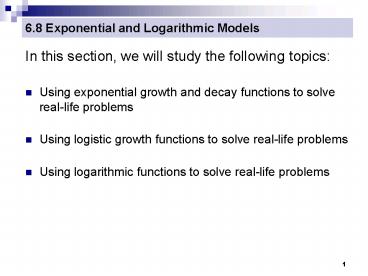6.8 Exponential and Logarithmic Models - PowerPoint PPT Presentation
1 / 17
Title:
6.8 Exponential and Logarithmic Models
Description:
6.8 Exponential and Logarithmic Models In this section, we will study the following topics: Using exponential growth and decay functions to solve real-life problems – PowerPoint PPT presentation
Number of Views:208
Avg rating:3.0/5.0
Title: 6.8 Exponential and Logarithmic Models
1
6.8 Exponential and Logarithmic Models
- In this section, we will study the following
topics - Using exponential growth and decay functions to
solve real-life problems - Using logistic growth functions to solve
real-life problems - Using logarithmic functions to solve real-life
problems
2
Common Mathematical Models
Many business applications and natural phenomena
can be modeled by exponential and logarithmic
functions. In this section we will use
exponential, logistic, and logarithmic models to
solve some real-life applications.
3
An Exponential Growth Model
Another way of writing the exponential growth
model is If k gt 0, the function models the size
of a growing entity. If k lt 0, the function
models the size of a decaying entity. A0 is the
original amount, or size, of the entity at time t
0. A is the amount at time t. k is a constant
representing the growth rate.
4
An Exponential Growth Model
- Example
- In 1970, the U.S. population was 203.3 million.
By 2003, it had grown to 294 million. - Find the exponential growth function that models
the U.S. population growth for 1970 through
2003. - According to this exponential model, in which
year will the U.S. population reach 315 million?
5
An Exponential Growth Model (continued)
Solution Use the model . In
this example, A represents ______________________
_____________________ A0 represents
__________________________________________ t
represents _______________________________________
____ Since the population is increasing, k is a
______________ number. Substitute the value
________ for A0 in the growth model
6
An Exponential Growth Model (continued)
We are given that the population in 2003 was 294
million. 2003 is _________ years after
1970. Therefore, when t ______, the value of
A is ___________. On the graph, this would be
represented as the point ( ,
) Substitute these values into the growth model
to find the value of k, the growth rate
7
An Exponential Growth Model (continued)
Now we substitute the value of k into the growth
model to obtain the exponential growth model for
the U.S. population. It is
To find the year in which the population will
reach 315 million, substitute 315 for A in the
model we just found and solve for t.
8
Applications of Logistic Growth Models
Logistic growth functions are used to model
situations where initially there is an increasing
rate of growth followed by a decreasing rate of
growth. Some common examples include the spread
of a disease within a population and the growth
of certain populations. In these cases, the
functions have an upper bound which is equal to
the maximum population capacity. This upper bound
and the line y 0 are the horizontal
asymptotes of the graphs of logistic functions.
9
Graph of Logistic Model
Domain (-?, ?) Range (0, c) Horizontal
Asymptotes y 0, y c
10
A Logistic Growth Model
- Example
- Fruit flies are placed in a half-pint milk bottle
with a banana (for food) and yeast plants (for
food and to provide stimulus to lay eggs).
Suppose that the fruit fly population P after t
days is given by - What is the carrying capacity of the half-pint
bottle? (That is, what is the upper limit of the
population?) - How many fruit flies were initially placed in the
half-pint bottle? - When will the population be 180?
11
A Logistic Growth Model (continued)
- Solution
- We can use the TABLE feature on the graphing
calculator table to find P(t) as t??.
y 230
y 0
P approaches 230 as t gets increasingly larger.
Notice, the LIMITING CAPACITY IS THE NUMERATOR
OF THIS FUNCTION. It is also the upper horizontal
asymptote of the graph of this function. (y 0
is the lower asymptote). So, the carrying
capacity of the bottle is _______ fruit flies.
12
A Logistic Growth Model (continued)
- Solution
- To find the initial number of fruit flies in the
bottle, we need to find P(0). - Algebraically Graphically
Initially, there were ________ fruit flies in
the half-pint bottle.
13
A Logistic Growth Model (continued)
- Solution
- To find when the population will reach 180, set
P(t)180. - Algebraically Graphically
It will take approx. _______ days for the pop.
to reach 180 fruit flies.
14
Applications of Logarithmic Models
- Many relations between variables are best modeled
by a logarithmic function. - Some common examples include
- the relation between an earthquakes magnitude
and intensity on the Richter scale, - the relation between atmospheric pressure and
height, - the relation between sound level (in decibels)
and intensity, - as well as many economic models.
15
A Logarithmic Model
Example The loudness L, in bels (named after
______________________), of a sound of intensity
I is defined to be where I0 is the minimum
intensity detectable by the human ear.
The bell is a large unit, so a subunit, the
decibel, is generally used. For L, in decibels,
the formula is
16
A Logarithmic Model (cont)
- Find the loudness, in decibels, for each sound
with the given intensity. - Library
- Dishwasher
- Loud muffler
17
- End of Sect. 6.8































